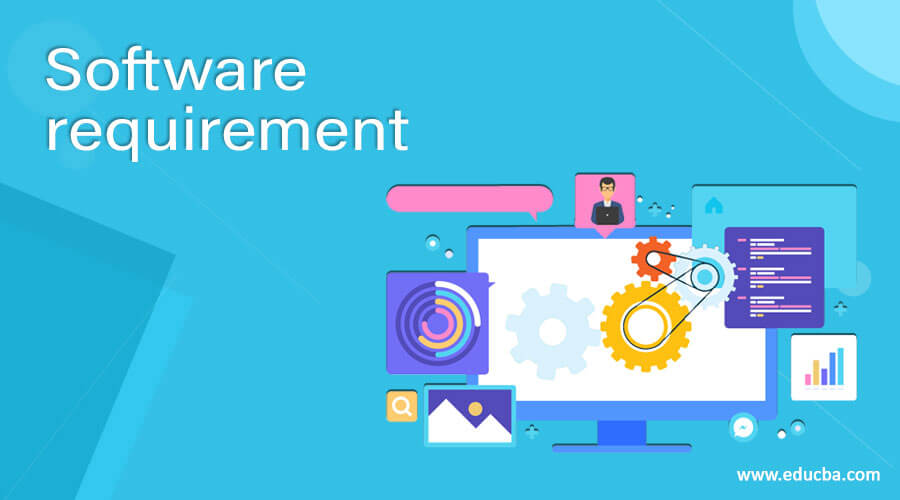Updated April 1, 2023
Introduction to Software requirements
Software requirement is a condition needed by the user to solve a problem or achieve a goal. Defining software requirements is the first step in the development life cycle. But, in many situations, enough care is not taken in establishing correct requirements. This causes problems, later in the development life cycle and more time and money is spent on fixing these problems. This. requirements must be established in a systematic way to ensure their accuracy and completeness. For example, the requirement for any vehicle could be that the maximum speed to be at least 120mph, the fuel tank should have at least 5 liters volume, etc.
List of Software requirements
Here are the following list of various software requirements:
1. Functional requirements
Functional requirements describe the processing of the information. Functional requirements are the services that a system could provide..e the do’s and don’ts of the system when particular input is given. It describes what the system should do in a particular condition. For example, bank software has functions like open account, close account, without amount, credit amount, load, policies, etc.
2. Nonfunctional requirements
Nonfunctional requirements support the business standards and business environment. These are the constraints applied to the services of the system. Nonfunctional requirements maybe the color of the user interface, speed of any input-output communication, security, etc. For example, performance, reliability, the security of the system. Nonfunctional requirements are categorized into three categories which are as follows
- Product requirements: it states the behavior of the product – performance, reliability, portability, usability.
- Organizational requirements: It specifies the policies and procedures followed in the user’s and developer’s organization – process policies, implementation policies, and delivery policies and procedures.
- External requirements: It specifies the external factors of the system and the development process – interoperability, ethics.
3. User requirements
User requirements are also called functional requirements as they state what functions are expected from a system by the users. It describes the service and constraints of the system and natural language and diagram. User requirements are readable and understandable by everybody. It serves as the business objectives.
4. System requirements
System requirements elaborate on the user requirements to get a more detailed and precise idea of what a system should do. It describes the services and constraints of the system in detail. It is useful for designing and developing the system. System requirements support the structured presentation covering all the classes.
Suppose the example of the library, where the functional requirement is a library system should allow borrowing books from the library. A nonfunctional requirement is a library system should provide a borrow function allowing the user to borrow the book. The transaction fails if th book is already borrowed or if the book is not available in the library or if the user has already borrowed the maximum number of the allowed books or if the user Owes any penalty.
5. Software documentation
Software documentation is called SRS (Software requirement specification). It lists out all the requirements consistently stated by the user. Great SRS leads to a great product. A great product can be created only from a great specification. System and software these days are so complex that to get on with the design before knowing what you are going to build is foolish and risky. SRS forms the basis for agreement between customers and development organizations on what the software product is expected to do. It reduces the development effort. It also forms a base for cost estimation and project scheduling. SRS provides a baseline for verification and validation. It facilitates the transfer of new software to new environments. It serves as a basis for software improvement.
Characteristics of SRS
- Complete: A simple judge of this is that it should be all that is needed by the software designers to carry the software
- Consistent: The SRS should be consistent within itself and consistent with its reference documents.
- Verifiable: Provide quantitative requirements like every keystroke should provide a user response within 100 milliseconds.
- Modifiable: Having the same requirements in more than one place may not be wrong but leads to making the document not maintainable.
- Traceable: In most organizations, it is sometimes useful to cony the requirements in the SRS to a higher-level document.
Examples of SRS
- Introduction
Product Overview
Purpose
Scope
Reference
Definitions and Abbreviations
- Overall Description
Product perspective
Product Functions
User characteristics
General Constraints
Assumptions and Dependencies
- Specific Requirements
External Interface requirements
User interfaces
Hardware interfaces
Software interfaces
Communication protocols
Memory Constraints
Operation
Product function
Assumption and Dependency
Software product features
Software system attributes
Reliability
Availability
Security
Maintainability
Portability
Performance
Database Requirements
Other Requirements
- Additional Materials
Conclusion
In this article, we have discussed the various software requirements like functional requirements, non-functional requirements, user requirements, system requirements, and Software documentation. We have also created a sample SRS to understand the concept in a better manner.
Recommended Articles
This is a guide to Software requirements. Here we discuss the various software requirements and also created a sample SRS to understand the concept in a better manner. You may also look at the following articles to learn more –



